Pac-Man Fever (album)
| Pac-Man Fever | ||||
|---|---|---|---|---|
 | ||||
| Studio album by | ||||
| Released | January 1982 | |||
| Recorded | 1981 | |||
| Genre | Rock | |||
| Length | 33:24 | |||
| Label | Columbia/CBS Records (1982) RC 37941 Buckner & Garcia Productions (1999) K-tel Entertainment (2002 version) | |||
| Producer | Buckner & Garcia | |||
| Buckner & Garcia chronology | ||||
| ||||
| Review scores | |
|---|---|
| Source | Rating |
| Allmusic | |
Pac-Man Fever is a 1982 album recorded by Buckner & Garcia. It is also the name of the first song on that album. Each song on the album is about a different classic arcade game, and uses sound effects from that game. The album was originally released in LP, cassette, and 8-track tape formats, and was later completely re-recorded for re-release on CD in 1999 and 2002.
The title song, "Pac-Man Fever", was released as a single in December 1981 and became a top-ten hit, peaking at #9 in March 1982 on the Billboard Hot 100[2] and earning Gold certification by the RIAA for selling over a million copies;[3] the single sold 2.5 million copies in total as of 2008.[4] It had been released independently earlier in the year on the BGO Records label, before being picked up by CBS. The album's second single, "Do the Donkey Kong", peaked at #103 on Billboard's Bubbling Under Hot 100 Singles chart.[5] Like the title song, the album itself went on to receive a Gold certification from the RIAA, for over 500,000 records sold;[6] the album sold 1,200,000 copies in total by the end of 1982. The duo performed both of these singles on American Bandstand on March 20, 1982,[7] as well as appearing later that day on Solid Gold,[8] singing "Pac-Man Fever".
The album was completely rerecorded in 1999 for CD release because the original album is still owned by Columbia and they reportedly declined to release it on CD. One interesting factoid is when Buckner & Garcia recorded "Mousetrap", they were unable to find a copy of the arcade game anywhere (as it was a rare game from the get go and failed due to it being seen as a Pac Man clone), so they recorded the dog and cat sounds at a pet store.
Track listing
| No. | Title | Game | Length |
|---|---|---|---|
| 1. | "Pac-Man Fever" | Pac-Man | 3:49 |
| 2. | "Froggy's Lament" | Frogger | 3:18 |
| 3. | "Ode to a Centipede" | Centipede | 5:37 |
| 4. | "Do the Donkey Kong" | Donkey Kong | 4:24 |
| 5. | "Hyperspace" | Asteroids | 4:07 |
| 6. | "The Defender" | Defender | 4:02 |
| 7. | "Mousetrap" | Mouse Trap | 4:01 |
| 8. | "Goin' Berzerk" | Berzerk | 4:17 |
Personnel
- Gary Garcia: Vocals, Keyboards, Synthesizers, Percussion (Cowbell)
- Jerry Buckner: Vocals, Keyboards, Synthesizers
- Mike Stewart: Moog synthesizer on tracks 7 and 8
- Chris Bowman, Rick Hinkle: Rhythm and Lead Guitar
- Larry McDonald: Bass
- Ginny Whitaker: Drums, Percussion
- David "Cozy" Cole: Electronic Drums
"Froggy's Lament" also pays tribute to Smilin' Ed McConnell and Froggy the Gremlin from Andy's Gang with its lyrics "Hiya, kids" and "Plunk your magic twanger, Froggy!"
References
- ^ Allmusic review
- ^ "Pac-Man Fever". Time Magazine. April 5, 1982. Retrieved October 15, 2009.
Columbia/CBS Records' Pac-Man Fever...was No. 9 on the Billboard Hot 100 last week.
- ^ "Popular Computing". Vol. Volume 2. McGraw-Hill. 1982. Retrieved August 14, 2010.
Pac-Man Fever went gold almost instantly with 1 million records sold.
{{cite news}}:|volume=has extra text (help) - ^ Turow, Joseph (2008). Media Today: An Introduction to Mass Communication (3rd ed.). Taylor & Francis. p. 554. ISBN 0-415-96058-4. Retrieved 29 January 2012.
- ^ Joel Whitburn's Bubbling Under the Billboard Hot 100 1959-2004
- ^ RIAA Gold & Platinum Searchable Database - Pac-Man Fever Archived 2015-09-04 at the Wayback Machine. RIAA.com. Retrieved 2009-11-01.
- ^ "American Bandstand Season 25 Episode Guide". TV.com. March 20, 1982. Retrieved August 14, 2010.
- ^ "Solid Gold Season 2 Episode Guide". TV.com. March 20, 1982. Retrieved August 14, 2010.
